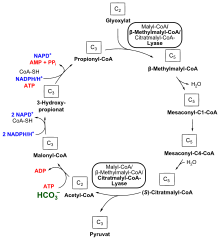Many photosynthetic life forms (plants, algae, phototrophic and chemoautotrophic bacteria, and archaea) require a way to utilize carbon into their metabolic pathways. This usually occurs in pathways that fix carbon from carbon dioxide (CO2). In the 3-hydroxypropionate bicycle, photosynthetic organisms like Chloroflexus aurantiacus, fix CO2 and bicarbonate (HCO3 ) as part of their metabolic processes.
Pathway
The 3-hydroxypropionate bicycle, also known as the 3-hydroxypropionate pathway, is a process that allows some bacteria to generate 3-hydroxypropionate using carbon dioxide. It is divided into two parts or reactions. The overall reaction of the 3-hydroxypropionate pathway is 3 HCO3− + 5 ATP + 6 NADPH + 1 quinone → 1 pyruvate + 6 NADP + 1 quinoneH2 + 3 ADP + 3 phosphate + 2 AMP + 2 pyrophosphate.

Part I
In this pathway CO2 is fixed (i.e. incorporated) by the action of two enzymes, acetyl-CoA carboxylase and propionyl-CoA carboxylase. These enzymes generate malonyl-CoA and (S)-methylmalonyl-CoA, respectively.
Part II
Malonyl-CoA, in a series of reactions, is further split into acetyl-CoA and glyoxylate. Glyoxylate is incorporated into beta-methylmalyl-coA which is then split, again through a series of reactions, to release pyruvate as well as acetate, which is used to replenish the cycle.

Prevalence
This pathway has been demonstrated in Chloroflexus, a nonsulfur photosynthetic bacterium; however, other studies suggest that 3-hydroxypropionate bicycle is used by several chemotrophic archaea. T In E. coli 3-hydroxypropionate bicycle has been studied and found to be insensitive to oxygen. This means that within the pathways there is nothing that oxygen can affect because in either part of the pathway or the oxygen is used to drive the reaction forward.
See also
References
- ^ Tabita, F. Robert (2009-12-15). "The hydroxypropionate pathway of CO2 fixation: Fait accompli". Proceedings of the National Academy of Sciences. 106 (50): 21015–21016. Bibcode:2009PNAS..10621015T. doi:10.1073/pnas.0912486107. ISSN 0027-8424. PMC 2795556. PMID 19996176.
- Herter, Sylvia; Fuchs, Georg; Bacher, Adelbert; Eisenreich, Wolfgang (June 2002). "A Bicyclic Autotrophic CO2 Fixation Pathway in Chloroflexus aurantiacus". Journal of Biological Chemistry. 277 (23): 20277–20283. doi:10.1074/jbc.m201030200. ISSN 0021-9258.
- ^ Zarzycki, Jan; Brecht, Volker; Müller, Michael; Fuchs, Georg (2009-12-15). "Identifying the missing steps of the autotrophic 3-hydroxypropionate CO2 fixation cycle in Chloroflexus aurantiacus". Proceedings of the National Academy of Sciences of the United States of America. 106 (50): 21317–21322. doi:10.1073/pnas.0908356106. ISSN 1091-6490. PMC 2795484. PMID 19955419.
- Hügler, Michael; Sievert, Stefan M. (2011). "Beyond the Calvin Cycle: Autotrophic Carbon Fixation in the Ocean". Annual Review of Marine Science. 3 (1): 261–289. Bibcode:2011ARMS....3..261H. doi:10.1146/annurev-marine-120709-142712. PMID 21329206.
- Mattozzi, Matthew d.; Ziesack, Marika; Voges, Mathias J.; Silver, Pamela A.; Way, Jeffrey C. (March 2013). "Expression of the sub-pathways of the Chloroflexus aurantiacus 3-hydroxypropionate carbon fixation bicycle in E. coli: Toward horizontal transfer of autotrophic growth". Metabolic Engineering. 16: 130–139. doi:10.1016/j.ymben.2013.01.005.